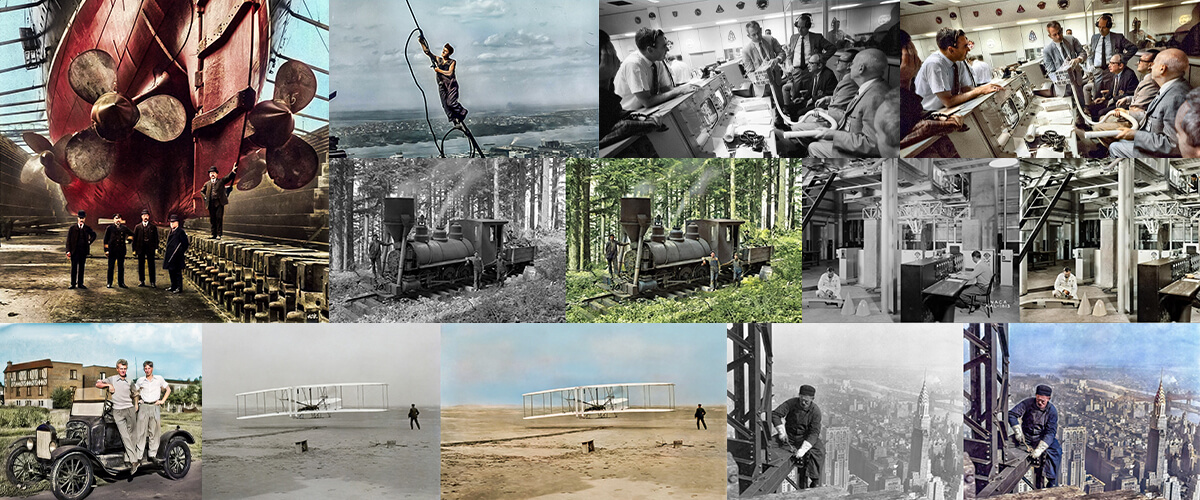Look back into the history of the engineering industry with these photos brought back to life in full color. Seeing these moments of mechanical history in the making really gives you a sense of what it would have felt like to be there, at the moment the photo was taken. Take an astonishing an unique look into the history of the construction and engineering industry in the 1800s and 1900s. In the days before 3D printing, point clouds, and IFC. It's the closest you'll get to stepping into a time-machine.
RMS Mauretania, Canada Dock in Liverpool, 1909

Colored from an image from the Tyne Wear Archives Museums.
RMS Mauretania was probably the most famous ship build in Canada Dock in Liverpool. The man in uniform is John Currie, Mauretania's first Chief Engineer.
The first successful flight of the Wright Flyer, Kitty Hawk, North Carolina, 1903, 10:35 a.m

The first successful flight of the Wright Flyer, by the Wright brothers. The Fédération Aéronautique Internationale considered it to be the first sustained and controlled, heavier-than-air, powered flight. The plane flew for 6.6 m (120 ft ) in 12 seconds. Wilbur Wright (right) let go just moments before the image was taken. He was holding the plane for balance. It's amazing to see how far we've come.
No. 610 Squadron Spitfire Mk V at Westhampnett, 11 April, 1943

Colored from an image at the Imperial War Museum
Ground staff work on a No 610 'County of Chester' Squadron Spitfire V at Westhampnett. Corporal Houseman (top), Corporal Phenna (with oil can) and Sergeant Moore (below) had all been with the Squadron since its formation in February 1936.
Steam-powered Fire Engine

Colored from an image from the Library of Congress
The exact date is unknown but is likely somewhere between, 1850 to 1860. Men carried the first fire engines by hand. Around 1840, horses began pulling fire engines, as the introduction of steam-powered, water pumps made the engines too heavy to carry. By 1905, gasoline began to power fire engines and their pumps, much as they are still to this day.
Workers stand in front of a steam train
 The date for this photo is not known but is likely to be in the mid to latter half, of the 19th century. The dirt on their hands and clothes shows how much soot these engines produced.
The date for this photo is not known but is likely to be in the mid to latter half, of the 19th century. The dirt on their hands and clothes shows how much soot these engines produced.
Ford Model T, 1923

Two men pose in front of a Ford Model T, at this time cars and cameras were only available to the super wealthy, so this was quite a moment for the pair. Production stopped 4 years later on May 26, 1927. Ford produced 15,000,000 during its 19-year manufacturing span.
Measuring engine power by electricity 1915 -- 1920

This photo illustrates a fundamental change in Engineering history. It was around this time that we were moving away from steam power and towards combustion engines and electrical power.
Lewis staff study the axial compressor of the Junkers Jumo 004. 1946

Lewis staff study the axial compressor of the German Junkers Jumo 004. This engine was the first production turbojet engine in use and the first axial compressor turbojet engine. Junkers produced 8,000 during WWII.
Wind tunnel at NASA, 1942

Test engineers in the test chamber, in the 7x10ft wind tunnel at the NASA Ames Research center.
Appollo 13 mission control, 15 April 1970

Even as late as the 1970s, color photography was rare. Here Deke Slayton (checked jacket) shows the adapter devised to make use of square Command Module lithium hydroxide canisters to remove excess carbon dioxide from the Apollo 13 LM cabin. The adapter was devised by Ed Smylie. Left to right: Flight Director Milton L. Windler, Deputy Director/Flight Operations Howard W. Tindall, Director/Flight Operations Sigurd A. Sjoberg, Deputy Director/Manned Spaceflight Center Christopher C. Kraft, and Director/Manned Spaceflight Center Robert R. Gilruth.
Construction workers on the Empire State Building, 1930

Back in the 1930s, safety wasn't a priority, no ropes, and no harness! Incredibly only 5 of the 3,400 men working on the Empire State building, lost their lives during the construction. In contrast, 96 out of a total of 21,000 workers lost there lives during the construction of the Hoover Dam, which was built around the same time.

Once complete, the Empire State building was the tallest building in the world for 40 years.
Draftsmen correcting printing plates, March 13, 1939

Technical drawing has come a long way. But, before there were laptops and BricsCAD, there was good, old-fashioned pencil, paper, and ink. Here draftsmen are correcting geological survey printing plates, at The Department of Interior Geological Survey Section, Washington DC.
Architects and draftsmen, Washington DC, February, 1936

These men are working at 2020 Massachusetts Avenue, Rural Resettlement, Washington DC, creating architectural plans and drawings the traditional way. I would be another 27 years before Ivan Sutherland, MIT created SKETCHPAD, largely considered to be the first software to demonstrate the principles and feasibility of CAD.
Drafting Room, Aircraft Engine Research Center, Cleveland Ohio, 1942

Drafting Room in Engine Research Building showing men at work at the Aircraft Engine Research Laboratory. The NACA (National Advisory Committee for Aeronautics), Aircraft Engine Research Center, Cleveland Ohio, (now the John H. Glenn Research Center at Lewis Field).
Workmen manufacturing locks, Trio Fabrikker, Norweg, 1902-1904.

The workers here are producing door locks, door knobs, hinges at one of the Trio factories.
Fancy making your own Engineering History?
Note: These colors are not historically accurate. They are artists impressions and show how the scene could have looked at the time the image was shot. These vintage photos have been recolored using the power of AI, the super cool SGcolouris tool, and a little retouching magic.

